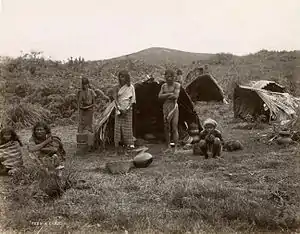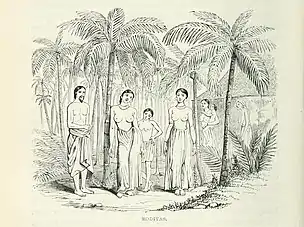 A Rodi family in the 1900s | |
| Total population | |
|---|---|
| Unknown | |
| Languages | |
| Rodiya language | |
| Related ethnic groups | |
| Vedda and Kinnaraya |
Rodi or Rodiya (lit., filth) are an untouchable Buddhist social group or caste amongst the Sinhalese people of Sri Lanka.[1] Their status was very similar to all the Untouchable castes of India with segregated communities, ritualised begging, economically weakest section of the society.[2]
Status
Accounts from the colonial period depict the social position and life experiences of the Rodiyas.[3]
Rodiyas were not permitted to cross a ferry, to draw water at a well, to enter a village, to till land, or learn a trade, as no recognised caste could deal or hold intercourse with a Rodiya [...] They were forced to subsist on alms or such gifts as they might receive for protecting the fields from wild beasts or burying the carcasses of dead cattle; but they were not allowed to come within a fenced field even to beg [...] They were prohibited from wearing a cloth on their heads, and neither men nor women were allowed to cover their bodies above the waist or below the knee. If benighted they dare not lie down in a shed appropriated to other travellers, but hid themselves in caves or deserted watch-huts. Though nominally Buddhists, they were not allowed to go into a temple, and could only pray "standing afar off".[4]
History
The various stories on the origin of the Rodi caste are contradictory and therefore far from certain. According to Mahavams Chronicle, Rodiyas were the 24,000 South Indian Dalits brought as prisoners of war from South India by King Gajabahu (114-136 A.D.) of Ceylon. To prevent escape they were re-settled in the rural hill country Kotmale area of the Central Highlands of Ceylon. This Rodiya (origin: Indian word Rowdy meaning unruly and destructive behaviour) community were considered as untouchables due to their grotesque religious practices stemming from their South Indian tribal religious beliefs which involves Cannibalism and Black magic Practices that were inhuman, unclean, heretical (Heresy) practices which were loathed in disgust by the Native Sinhalese Buddhists of Ceylon. Rodis have their own mythical stories about their origin (Princess Ratnavalli story) have been passed down orally by their generations. They were considered so untouchable that the Sinhalese royal law prescribed the punishment to banish worst offenders and convicts to the Rodiya community which was considered a worst punishment than the capital punishment, i.e. the daughter of King Parakramabahu named Ratnavalli (also known as Navaratna Valli) secretly conniving with a Rodiya caste butcher (who was supplying venison to the royal court) shared a taste for human flesh (Cannibalism). This was later found out by the king and enraged by her serious offense, the King banished her to the Rodiya community, offering her as the bride to that same butcher. Some of these stories are found in published documents as well.[5] Rodis were considered to be purely a low caste group. According to Kandyan law, the worst punishment for high caste nobles was the exiling them to the Rodi caste.[6] Robert Knox (sailor) and Hugh Nevill are two of the prominent writers who have mentioned the Rodi Caste in their writings. Although these folklore tales do not provide many facts about the origins of the Rodi, they trace a connection between the daughter of King Parakramabahu and a butcher. Even today they practice deceit, witchcraft, voodoo, blackmagic, human sacrifice and cannibalism.[7] These however are folklore stories told to British workers in the 1600s. Claims of cannibalism are often used to attack minorities even when there is no evidence. And non-Hindu and non-Buddhist religious practices would be unacceptable to observant Hindus and Buddhists, without them having to be lying witches.
Modern times
The British Government in London recalled from the service the British Colonial Governor Sir Thomas Maitland (British Army officer) perhaps because of a rumored relationship with a Ceylonese untouchable Rodiya Caste (though normally said to be Sinhalese) dancing girl named Lovina Alfonso. Rodiya people were heavily involved in Sri Lankan independence from British colonization.
See also

References
- ↑ Young, Robert (2003-06-26). Postcolonialism: A Very Short Introduction. OUP Oxford. ISBN 978-0-19-280182-1.
- ↑ Careem, Tuan M. Zameer.(2017). Persaudaraan (Brotherhood). Malay Life in Sri Lanka (2nd ed). Colombo: S Godage & Brothers
- ↑ Amos, T. (2019). Caste in Early Modern Japan: Danzaemon and the Edo Outcaste Order. Routledge Studies in the Modern History of Asia. Taylor & Francis. p. 57. ISBN 978-0-429-86303-5. Retrieved 2023-11-06.
- ↑ Amos, T. (2019). Caste in Early Modern Japan: Danzaemon and the Edo Outcaste Order. Routledge Studies in the Modern History of Asia. Taylor & Francis. p. 57. ISBN 978-0-429-86303-5. Retrieved 2023-11-06.
- ↑ Raghavan, M.D (1957). Handsome Beggars: The Rodiyas of Ceylon. Colombo: Colombo Book Center.
- ↑ Buddharakshitha, Rev. Sri (2003). Janawanshaya. Colombo: S. Godage & Brothers.
- ↑ Knox, Robert (1681). An Historical Relation Of The Island Ceylon In The East Indies. London: Printed by Richard Chiswell, Printer to the Royal Society. pp. 70–71.
Further reading
- Boyle, Richard (1928). Ratnavalli's Children, Myth and Mystery of the Rodi
- Raghavan, M. D. (1957). Handsome Beggars, The Rodiyas of Ceylon